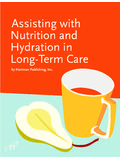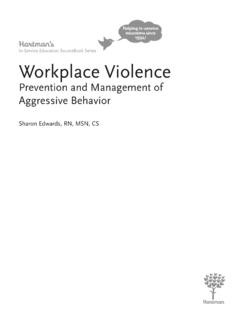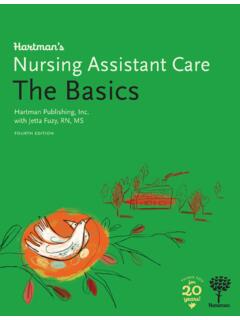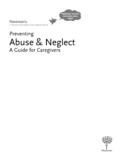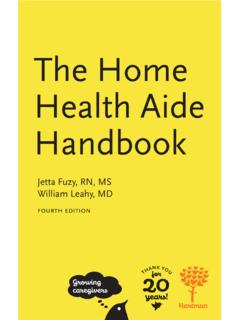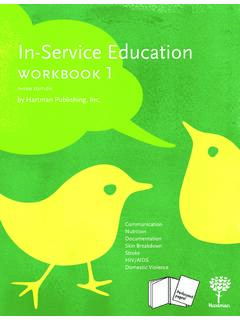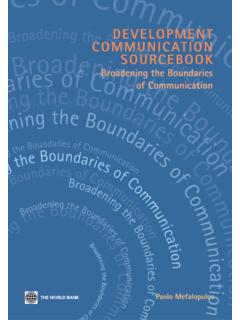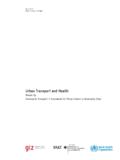Transcription of The Importance of Observation and Documentation
1 Helping in-service educators since 1994!Hartman's In-Service Education sourcebook SeriesThe Importance ofObservation and DocumentationThe Importance ofOBSERVATION andDOCUMENTATIONC ontributorJetta Fuzy, RN, MSDirector of Education & TrainingHealth Education, Lauderdale, FloridaThe publisher gratefully acknowledges the contributions of thefollowing individuals who reviewed this material:Sharon Edwards, RN, MSN, CSClinical Nurse SpecialistSuperior Home Health CareKingsport, TennesseeCatherine A. Whaley, RN, CRNID irector of EducationWoodbine Rehabilitation & Healthcare CenterAlexandria, Virginia Albuquerque, NMNOTICE TO THE READERT hough the guidelines contained in this text are based onconsultations with health care professionals, they should not beconsidered absolute recommendations. The instructor and readersshould follow employer, local, state, and federal guidelines concerninghealth care practices. These guidelines change, and it is the reader'sresponsibility to be aware of these changes and of the policies andprocedures of her or his health care publisher, author, editors, and reviewers cannot accept anyresponsibility for errors or omissions or for any consequences fromapplication of the information in this book and make no warranty,express or implied, with respect to the contents of this does not warrant or guarantee any of the productsdescribed herein or perform any analysis in connection with any of theproduct information contained : Jetta Fuzy, RN, MSDevelopment Editor: Celia McIntireComposition: Tech Reps, : John W.
2 DavisIllustration: Celia McIntireISBN 1-888343-13-3 1998 Hartman Publishing, Inc. Allrights reserved. Limited permission tophotocopy the labeled handouts in thistext is granted to direct purchasers of thisbook from the publisher. Copies canonly be made for employees orstudents at ONE LOCATION of amulti-site employer or school. No otherpart of this book may be reproduced, inany form or by any means, withoutpermission in writing from the of ContentsFYI5 Introduction and Assessment7 Handout Intro-1 Assessment A ( )Handout Intro-2 Assessment A Answer Key (pg. 10)Handout Intro-3 Note-Taking Worksheet (pg. 12)Handout Intro-4 Key Terms (pg. 16)Learning Objective 1: Define Documentation and identify its importance17 Handout 1-1 What is Documentation ? (pg. 19)Transparency 1-1 What is Documentation ? (pg. 20)Transparency 1-2 Sources of Documentation (pg. 21)Learning Objective 2: Describe four forms commonly used in documentation22 Handout 2-1 Commonly Used Documentation Forms (pg.)
3 24)Transparency 2-1 Four Forms (pg. 29)Learning Objective 3: Describe legal aspects of documentation30 Handout 3-1 Legal Aspects (pg. 31)Transparency 3-1 Legal Aspects (pg. 33)Learning Objective 4: List eight reasons for careful documentation34 Handout 4-1 Eight Reasons for Careful Documentation (pg. 35)Transparency 4-1 Eight Reasons for Careful Documentation (pg. 36)Transparency 4-2 Continuity of Care (pg. 37)Transparency 4-3 Documentation is Communication (pg. 38)Learning Objective 5: Define objective and subjective information andobservation39 Handout 5-1 Objective vs. Subjective (pg. 41)Transparency 5-1 Objective Observations (pg. 42)Transparency 5-2 Subjective Information (pg. 43)Handout 5-2 Signs or Symptoms (pg. 44)Handout 5-3 Signs or Symptoms Answer Key (pg. 45)Learning Objective 6: Describe basic observations essential to dailydocumentation46 Transparency 6-1 Basic Observations for Documentation (pg. 47)Handout 6-1 Basic Observations for Documentation (pg.
4 48)Learning Objective 7: List nine guidelines for documentation51 Handout 7-1 Nine Guidelines for Documentation (pg. 53)Transparency 7-1 Nine Guidelines for Documentation (pg. 54)Learning Objective 8: Identify commonly misspelled words and guidelines toavoid spelling and grammar errors55 Handout 8-1 Spelling Test (pg. 56)Transparency 8-1 Spelling Test Answer Key (pg. 57)Handout 8-2 Four Guidelines to Avoid Errors (pg. 58)Transparency 8-2 Four Guidelines to Avoid Errors (pg. 59)Learning Objective 9: List the most common abbreviations used in healthcare 60 Handout 9-1 Abbreviations Test (pg. 61)Transparency 9-1 Abbreviations Test Answer Key (pg. 62)Learning Objective 10: Describe incident reporting and recording63 Handout 10-1 Incidents (pg. 65)Transparency 10-1 Sample Incident Form (pg. 66)Closing and Assessment67 Handout Closing-1 Assessment B (pg. 68)Handout Closing-2 Assessment B Answer Key (pg. 70)In-Service Evaluation Form71 Certificate of Completion72 Record Keeping Form73 For More Information745 FYIhe qualifications for a health carepolicies and forms your agency uses, allTgiver include maturity, gentleness,rules and guidelines in this program willkindness, sensitivity, and aapply.
5 Willingness to answer human needs. Healthcare givers must possess intelligence andOther areas of Documentation that may beobservation skills, be physically able tonew content include incident reporting, legalperform the tasks required, and work wellaspects of Documentation , Observation andunder professional supervision. As if thatrecording, and a section on abbreviationsisn't enough, they must be able to documentand commonly misspelled as well! Documentation is becoming a very vitalthe skills of the assistant as a vital aspect offunction of nursing assistants and homethe total care for clients. To validate thishealth aides. Because aides and assistantscare and to best utilize the time and talent ofspend more time with a resident or clientnursing assistants, proper writing skills arethan any other member of the health careas important as caregiving , they have more opportunities to relateto that person and his or her family. It isThroughout this in-service, you shouldimportant that aides communicate theiremphasize the responsibility of ALL healthobservations to the other members of thecare givers to carefully and accuratelyhealth care team.
6 They can best do thisdocument patient care, patient response, andthrough accurate in of services can help ensureThis in-service can be divided into fivethat the care provided is appropriate andsections for teaching purposes:continuous. Documentation is also the basisof the reimbursement system. Because ofDefinition of Documentation :these reasons, aides and assistants must keepLearning Objectives 1, 2their charting skills accurate. This in-serviceis a review of previously taughtReasons for Documentation : Documentation guidelines and Objectives 3, 4It is important that your agency's or facility'spaperwork be very familiar to yourHow to Observe Accurately:employees. For this reason, you will want toLearning Objectives 5, 6include a review of specific companypolicies and paperwork as a part of this in-How to Document Accurately:service Objectives 7, 8, 9, 10 Every agency and facility has differentPractice Documenting:policies about Documentation . Some areLearning Objectives 2, 7, 10simple check-off lists and others have spacefor writing in sentences.
7 No matter whatThe industry is relying more and more on7 Lesson Plan - Introduction and AssessmentIntroduction and AssessmentEstimated Time: 10-15 minutesTools:Handout Intro-1 Assessment AHandout Intro-2 Assessment A Answer KeyHandout Intro-3 Note-Taking WorksheetHandout Intro-4 Key TermsLearning Activity:AssessmentDistributeHandout Intro-1 Assessment AAllow participants enough time to finish the assessment. This is a goodway for them to find out how much they already know. Advise themthat this is not a pass or fail test, but a tool to help them evaluate theirknowledge. You may choose either to go over the answers as a lead-into discussion or repeat the same test at the end of the , Handout Closing-1 Assessment B (pg. 68) can be used as apost-test in place of this one at the end of the Intro-3 Note-TakingWorksheetEncourage participants to take notes during the in-service to help themorganize and remember the Intro-4 Key TermsReview the key terms as Intro-1 Assessment AName: Date:Mark each statement either T (True) or F (False).
8 The medical record is a legal You can document care given by a friend if that person is Documentation is a communication The only source of information that can be documented is what you Documentation is not actual proof of something seen or Leaving out information from the medical record is as much of a problem indocumentation as writing inaccurate Reimbursement is payment to the health care agency or facility for the costof caring for a client or You should carry a dictionary or keep one Symptoms are objective information, or what you can observe about a personin your A good example of a sign is Daily Documentation should reflect the client's or resident's Activities of DailyLiving and mental When documenting mobility and function, you do not have to include the useof assistive devices, such as walkers and Nutrition level is not an important part of Incidents are Incidents are documented on the medical Words such as "good" or "normal" are excellent words to use If you are unable to reach the supervisor, there is no need to document ANTEBIOTIC is a correct COMMODE is a correct of the following are correct (T) abbreviations and which are incorrect (F) abbreviations?
9 CHF stands for Cardiac Heart BRP stands for Bath Room FBS stands for Fasting Blood ADL stands for Activities the Doctor O stands for SOB stands for Sometimes Out of Intro-2 Assessment A Answer Key1. TrueA medical record may be used in court. (Learning Objective 3, 4)2. FalseHealth caregiver should only document care provided by self. (LearningObjective 3)3. True(Learning Objective 1, 4)4. FalseOther sources of Documentation include what you do and what informationthe client/resident or family members give. (Learning Objective 1)5. FalseDocumentation is proof or support of something seen, heard, or done.(Learning Objective 1, 3)6. TrueFor example, failing to note potential for self-injury. (Learning Objective 3)7. True(Learning Objective 3)8. True(Learning Objective 8)9. FalseSymptoms are subjective information, or what the client/resident tells you.(Learning Objective 5)10. True(Learning Objective 5)11. True(Learning Objective 6)12.
10 FalseYou must include any information that relates to ambulation and walking,including the use of walkers, canes, wheelchairs, etc. (Learning Objective 6)13. FalseNutrition is one of the thirteen basic observations. (Learning Objective 6)14. True(Learning Objective 10)15. FalseIncidents are only documented on incident forms. (Learning Objective 10)16. FalseAvoid such nonspecific words. (Learning Objective 7)17. FalseAll attempts to reach supervisors must be carefully documented. If you cannotreach the supervisor, you should leave a message and document that you didso. (Learning Objective 7)18. FalseANTIBIOTIC is correct. (Learning Objective 8)


